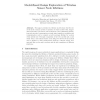Free Online Productivity Tools
i2Speak
i2Symbol
i2OCR
iTex2Img
iWeb2Print
iWeb2Shot
i2Type
iPdf2Split
iPdf2Merge
i2Bopomofo
i2Arabic
i2Style
i2Image
i2PDF
iLatex2Rtf
Sci2ools
EWSN
2007
Springer
2007
Springer
Model-Based Design Exploration of Wireless Sensor Node Lifetimes
This paper presents two lifetime models that describe two of the most common modes of operation of sensor nodes today, triggerdriven and duty-cycle driven. The models use a set of hardware parameters such as power consumption per task, state transition overheads, and communication cost to compute a node's average lifetime for a given event arrival rate. Through comparison of the two models and a case study from a real camera sensor node design we show how the models can be applied to drive architectural decisions, compute energy budgets and duty-cycles, and to preform side-by-side comparison of different platforms.
| Added | 25 Dec 2009 |
| Updated | 25 Dec 2009 |
| Type | Conference |
| Year | 2007 |
| Where | EWSN |
| Authors | Deokwoo Jung, Thiago Teixeira, Andrew Barton-Sweeney, Andreas Savvides |
Comments (0)

